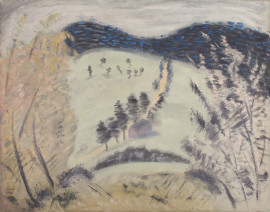
Milton Avery
Musical Landscape, c. mid-late 1930s
Gouache on paper
45.7 x 61 cm
18 x 24 in
18 x 24 in
It is a fine and natural blend he has though not easily defined. He is a poet, a colorist and a decorator; so excellent in each of these divisions that he might exist on any one of them, yet I presume being a poet will be his strongest claim. He has been doing landscape . . . in Vermont . . . He doesn’t really do the landscape, but, as we now say, the ‘emotion’ that he had when viewing it. These emotions must be akin to those of a musician, for he becomes, in his best… distinctly lyrical. Henry McBride Archives of American Art N68/95 quoted in Lit #194
Beginning in 1927, and through the mid 1930s, Milton Avery made a unique body of work, paintings in gouache on dark paper – in hues of green brown, blue, maroon and black. While many of these small paintings, most of them 12 x 18 inches, depict New York life – especially its beaches and waterways, theatre and vaudeville, Avery’s gouaches are also seen in his summer work, mostly painted in Gloucester and Vermont, as was Musical Landscape. Nor did Avery ever relinquish the medium entirely – we see gouache paintings in the 1950s, and he continued to use gouache and watercolor together to the end of his life. The opacity of gouache lends itself to broad areas of pure color and to the expressive use of the brush – making them closely related to the artist’s paintings in oil. Early exhibitions devoted to the gouaches were held at Gallery 144 West 13th Street in 1932 and Theodore A. Kohn Gallery in 1934. And Paul Rosenberg presented a show of Avery’s gouaches in 1945. One critic compared Avery gouaches to the work of Daumier and Ryder.
In 1938, Marsden Hartley wrote, “Avery is a kind of musician in his own right.” And in his 1936 commentary, Henry McBride compared one of Avery’s watercolors to “a sheet of Chinese music.”
Musical Landscape, with its extraordinary mood of ecstatic, improvisatory abandon, literally seems to impart the visual flow of a stanza. And, it is remarkable to see its spontaneity of tone emerge as a related canvas that marks a departure in Avery’s landscape oils – both in the emergence of a lighter tonality and touch and in the artist’s arrival at the compositional serenity and perfection characteristic of his classical years.
Musical Landscape is one of a pair of related works, the other being the oil on canvas Pale Fields. In the catalogue to the exhibition Milton Avery’s Vermont Jamie Franklin writes about the pairing: “Pale Fields is one of Avery’s lightest Vermont oils, both coloristically and in terms of paint handling. Yet it was, somewhat ironically, developed from a gouache executed on black construction paper, Musical Landscape, which makes effect use of the dark ground, especially for the mountain looming in the background. I find myself particularly drawn to a passage in the lower left of both works. In the gouache, the topmost of three wide horizontal strokes of yellow at bottom center, executed with what seems to be an unconscious quiver of the wrist, is positioned to the right of an oddly shaped area of reserved black paper, effortlessly evoking a small group of unruly bushes. The artist seems to have enjoyed the associative effectiveness of this seemingly spontaneous passage and took great pains to transcribe it in the final oil.”
Exhibitions
Milton Avery, Victoria Miro Mayfair, London, June 7 - July 29 2017Milton Avery’s Vermont, Bennington Museum, Vermont, USA, 2 July - 6 November 2016
Milton Avery, Victoria Miro, London, 7 June – 29 July, 2017
Literature
Milton Avery, essay by Edith Devaney. London: Victoria Miro, 2017, illustrated, n.p. Wajahat, Waqas.Publications
Franklin, Jamie, Karen Wilkin, et al. Milton Avery’s Vermont, ed. Robert Wolterstorff. Bennington Museum, Bennington, Vermont (2016). Listed page 69; plate 21, page 22; mentioned in the text page 36.
Milton Avery, Victoria Miro Mayfair, London (2017). Illustrated
